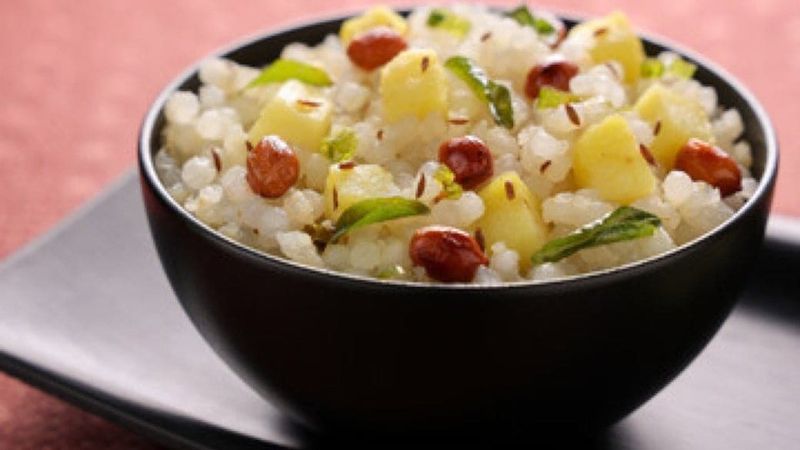

Our Review Process
Our articles undergo extensive medical review by board-certified practitioners to confirm that all factual inferences with respect to medical conditions, symptoms, treatments, and protocols are legitimate, canonical, and adhere to current guidelines and the latest discoveries. Read more.
Our Editorial Team
Shifa Fatima, MSc.
Author
Dr. Apoorva T, MHM.
MEDICAL ADVISOR
Sabudana for diabetes- Good or Bad
Sabudana or sago are pearl extracts from the tapioca plant. It is native to Asia, South America, and Africa. It is consumed all over India as a fasting food due to its high-calorie content. Individuals with diabetes have high blood sugar levels and need food rich in fibre and good carbohydrates that help reduce sugar levels. Individuals with diabetes can consume Sabudana as it is an essential source of carbohydrates and helps in the digestive process. Let us read more about is Sabudana good for diabetes
Table of Contents
Sabudana: Nutritional Profile
Sabudana is made of starch obtained from the tapioca plant. This starch is processed and made into small spheres to be ready for consumption. The Nutritional profile of 100 grams of Sabudana is as below:
| Sr. No | Nutrient | Grams |
|---|---|---|
| 1 | Carbohydrates | 88 |
| 2 | Calcium | 20 |
| 3 | Fibre | 1.37 |
| 4 | Zinc/potassium/Iron | 11 |
| 5 | Protein | 0.19 |
| 6 | Fat | 0.02 |
| 7 | Calories | 358 kcal |
Glycemic Index of Sabudana
Glycemic index of sabudana is 67. Its position is neither high nor low. When consumed in large quantities, it may have a mild effect on blood sugar levels. A diabetic's diet should consist primarily of items low on the glycemic index.

Things to Keep in Mind Before Consuming Sabudana
- All foods have a glycemic index, or the amount of sugar or carbohydrates in the food that determines the impact on blood sugar level after consumption. It should generally be less than 55 to count as a low sugar forming food. The glycemic index of Sabudana falls in the medium Glycemic Index category of 55-69, with a value of 67.
- Carbohydrates in sabudana get converted into glucose and sucrose, which spike blood sugar levels. When eaten in moderation, insulin and other substances in the body help regulate blood sugar level spikes. Individuals with insulin deficiency must consult a physician or dietician before consuming sabudana.
- Fibre helps to regulate the function of the intestines in digestion and excretion of waste products from the body.
- Sabudana is also a good source of calcium that helps form bone tissue.
- A bowl of sabudana contains 358 kcal, making it an instant source of energy during bodily stresses and fasting periods.

Advantages of Sabudana for Diabetes
can diabetic eat sabudana? Yes, sabudana is good for diabetes and they can also prepare sabudana khichadi as sabudana khichadi is good for diabetes when eaten in moderation. The Sabudana nutrition profile is incredible since it contains most of the essential nutrients like fiber, zinc, protein, fat, carbs, etc., needed by your body. The rich nutritional profile helps Sabudana offer the following advantages:
Cardiovascular health
Sabudana contains potassium, which is essential in regulating blood pressure. Relatively low sodium content in sabudana makes it good heart function. Sabudana is a natural, rich calcium source that strengthens bones in growing children. It has also helped older people restore their optimum bone density, alleviating osteoporosis symptoms. As a young adult, you can consume slightly more Sabudana, but middle-aged and older people should measure their serving and avoid overconsumption. Sabudana can augment bone health while preventing symptoms of kidney and gastrointestinal disorders. Also know about Indian diabetes diet.
Intestinal health
Fibre and some forms of carbohydrates, along with water, help maintain a balance between the number of nutrients absorbed and retained by the intestines and the waste products thrown out of the body. It is also a gluten-free food, which is essential for individuals with gluten intolerance. Thus, sabudana helps prevent constipation and maintains good nutrition in individuals with celiac disease (gluten intolerance).
Osteoporosis
Calcium forms the crux of our bones. It helps in new bone formation. Elderly individuals with diabetes may have weak bones due to age-related osteoporosis. Sabudana consumption in moderation may help build strong bones and prevent osteoporotic fractures.
Source of energy
Due to its high carbohydrate content, sabudana is a high-calorie food. On consumption, carbohydrates are converted to form energy-providing calories. Individuals with diabetes may benefit from sabudana before a workout or walking session. Sabudana has plenty of simple sugar and starches that are easily metabolized by the body to generate glucose to fulfill energy requirements. It also assists in the biochemical functions of tissues and cells. For this reason, Sabudana is also considered an ideal food item to consume post-fasting for an extended period. You can also have Sabudana after a workout to replenish the lost energy. It will help prevent any headaches, dizziness, fatigue, etc., caused by low energy.
Weight loss
Fats are present in negligible quantities in sabudana and therefore are suitable for individuals who are overweight or obese and struggle to reduce weight. Diabetes may cause weight gain, and sabudana may help control weight. It provides an excellent satiety value and makes you feel full for a longer time. Keep reading the article to understand can diabetics eat sabudana
Provides Essential Amino Acids
Sabudana is a healthy and unique plant-based source of high-quality proteins composed of key amino acids. Methionine is one of the sulphur-based amino acids in Sabudana that helps revive hair and skin health. Isoleucine and valine are other amino acids in Sabudana that help repair injured muscle tissues. The threonine amino acid enables proper enamel and tooth formation.
Improves Nervous System Functions
The tryptophan amino acid in Sabudana is crucial in maintaining equilibrium in your serotonin levels, helping reduce symptoms of insomnia, anxiety, etc. If you consume Sabudana in moderate quantities every day, it will help you improve your nerve impulse conduction. It will also activate memory centers in the brain, which is essential for relaxing your mind. It also helps promote sound sleep and maintain a good mood.
Helps Maintain Healthy Blood Sugar Levels
Due to the rich fiber content and ease of digestibility, Sabudana in moderate servings helps manage lifestyle diseases like obesity and diabetes. Even though Sabudana calories and carbohydrates are on the higher side, it also contains plenty of polyphenols, phytates, tannins, and other plant chemicals that slow the digestion process. It eventually lowers the blood sugar (glucose) levels in people diagnosed with diabetes mellitus.
Treats Diarrhea
Sabudana is rich in dietary fibers, so consuming it regularly in moderate amounts will help improve your bowel movement, promote optimal passage of food and other materials inside the intestine, regulate fecal bulk, and more. Having Sabudana as your breakfast will stimulate healthy metabolism, assist in averting colon cancer risk, and reduce diarrhea symptoms.
Side Effects of Sabudana for Diabetes
Sabudana for diabetes is a reasonably healthy food option, provided it is consumed in moderation. But excess consumption can lead to various side effects. Some of the most common Sabudana side effects are related to cyanide glycosides in cassava. An aquacyanocobyrinic acid sensor can detect it. The following side effects can be expected in some cases:
- Sabudana derived from cassava may have cyanogenic glucosides and other compounds that can affect your body’s iodine utilisation. It can also disrupt the body’s thyroid function leading to hypothyroidism.
- Diabetes patients allergic to latex can exhibit harmful reactions to Sabudana.
- Chronic intoxication of cyanide in Sabudana can cause neurological disorders.
- Due to children’s less weight and smaller body sizes, they are more prone to the risk of hydrogen cyanide toxicity.
- These are some possible side effects of Sabudana, but these are not as common as you think. If you buy good quality Sabudana and consume it in moderation, your chances of experiencing these side effects are very slim.
Also read about sugar free sweeteners
Ways to Consume Sabudana
Sabudana is a versatile food. It has been used to add nutrition to food products like dough and sauces. It can be used to make sweet and savoury dishes like
- Sabudana Khichdi
- Sabudana Bhel
- Sabudana Papad
- Sabudana Vada
- Sabudana Kheer
- Sabudana Thalipeeth
Sabudana khichadi is good for diabetes. Desserts made with sabudana may not be recommended for diabetes due to the high amount of sugar used for preparation. Also, fried sabudana should be consumed in moderation as it increases unsaturated fats in the blood. Fortified sabudana helps in improving insulin sensitivity. Sabudana must be soaked overnight, and should ideally be eaten with vegetables to enhance its nutritional value.
When to Consume Sabudana?
Being a high-calorie food, sabudana should be eaten in breakfast or lunch for it to be digested during daily activities. The energy produced after eating should be used up. It should not be consumed at dinner. It is usually eaten during fasting periods but can also be consumed before a workout session. Know about Indian breakfast for diabetes .
Sabudana: Overconsumption Risks
Sabudana may cause adverse effects like indigestion and hyperglycemia when consumed in unmoderated quantities. Individuals who are pregnant, breastfeeding, and have uncontrolled diabetes and thyroid disorders must consult a doctor before consuming sabudana. Know about high blood sugar symptoms.
Other Health Benefits of Sabudana
Sabudana can be used to gain weight in lean individuals due to the presence of essential fats. Antioxidants present in sabudana help reduce the impact of free radicals in the body, thus improving immunity against several diseases.
Bottomline
Sabudana may not be a superfood for diabetes but certainly provides fairly good nutrition and is an excellent source of instant energy. Individuals with diabetes must consult their diabetes specialist doctor or dietician before consumption.
Read more about Glyciphage 500mg, diabetes mellitus care plan & is azithromycin safe for diabetics.
FAQs
Is sabudana good for diabetes?
The glycemic index of sago is high, and it is also high in calories. Therefore Sabudana is not recommended for diabetics to eat in excess. But as Sabudana is rich in fiber and also helps in managing weight, Thus people with diabetes can eat Sabudana in moderation.
Does sabudana increase sugar levels?
Consuming sabudana every day can lead to a rise in overall blood sugar. It has a high amount of starch that can lead to a spike in the glucose levels of the body immediately after eating. Have sabudana for diabetes in moderation or combine it with fiber-rich vegetables. Also know about glucose fasting normal range.
What's the glycemic index of sabudana?
The glycemic index of sabudana is 67 which is considered pretty high, especially for a person with diabetes. It can have an impact on blood sugar levels.
Is Sabudana Gluten-free?
Yes, Sabudana is gluten-free. It doesn’t contain gluten, which is a wheat-based protein. People with gluten intolerance can easily include Sabudana in their daily diet. However, if you have diabetes, measure your servings to prevent any blood sugar spikes. Excess consumption can also cause bloating in some, so be careful of the quantity.
Is Sabudana Good for Weight Loss?
No, Sabudana is not good for weight loss. Since it contains high amounts of carbohydrates, little protein, and healthy fats, it isn’t considered a great option for weight management. It is also high in calories, which can easily imbalance your daily calorie consumption.
References
- https://www.healthline.com/health/diabetes/sabudana-diabetes
- https://pharmeasy.in/blog/ayurveda-uses-benefits-side-effects-precautions-of-sabudana/#:~:text=Sabudana%20derived%20from%20cassava%20may,thyroid%20function%20leading%20to%20hypothyroidism.&text=Chronic%20intoxication%20of%20cyanide%20may%20lead%20to%20neurological%20disorders.
Disclaimer
This website's content is provided only for educational reasons and is not meant to be a replacement for professional medical advice. Due to individual differences, the reader should contact their physician to decide whether the material is applicable to their case.








